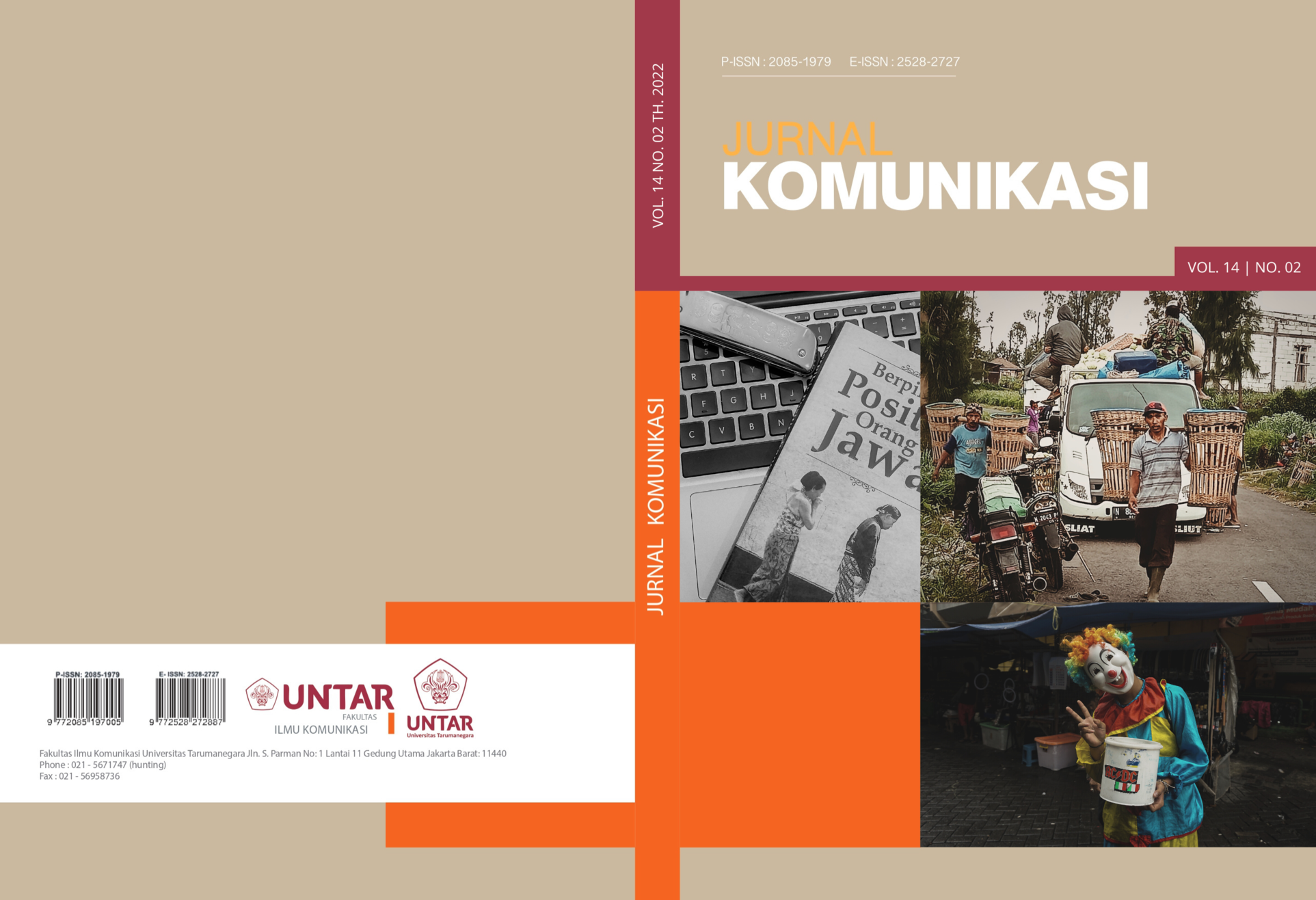Wellness and Herbal Tourism Based on Local Wisdom as an Alternative to ‘New Normal’ Tourism
Main Article Content
Abstract
The government initiated a wellness and herbal tourism program, in collaboration with the Indonesian Ministry of Tourism and Creative Economy with the Ministry of Health. This tourism cluster is prioritized because it has high impact in improving health, cultural and economic field. This type of tourism is considered would provide fresh air in the New normal situations that require people to remain side by side with the Covid-19 pandemic situation. The author examines concretely the marketing communication strategy of tourism stakeholders in developing the program to see how the establishment of wellness and herbal tourism based on local wisdom as an alternative in tourism industry, especially in the New normal era. The author uses a marketing communication strategy with the SOSTAC + 3Ms model of marketing communication analysis, which was popularized by PR. Smith. This theory is considered could describe the integrated marketing communication science in the tourism industry. This research was conducted using a qualitative descriptive method, with an emphasis on the naturalistic inquiry paradigm. Direct interviews were conducted with competent primary sources who represent their fields. The results of this study describe the tourism stakeholders in Solo have been prepared for the development of the wellness and herbal tourism program, with a focus on the local wisdom of Solo's custom. However, the development and preparation of the wellness and herbal tourism program is deemed not optimal, because internal and external conditions are still hampered tourism business in the midst of the Covid-19 Pandemic.
Article Details

This work is licensed under a Creative Commons Attribution-ShareAlike 4.0 International License.
This work is licensed under a Jurnal Komunikasi Creative Commons Attribution-ShareAlike 4.0 International License.References
Prawira, Aditya Eka. (2019). Diakses pada 5 Agustus 2021, dari https://www.liputan6.com/health/read/4115494/menkes-terangkan-perbedaan-wisata-kebugaran-dan-wisata-sehat
Gibran Bakal Bikin Wellness Tourism di Solo Pemijat Disertifikasi. (2020). Diakses pada 5 Agustus 2021, dari https://news.detik.com/berita-jawa-tengah/d-5244889/gibran-bakal-bikin-wellness-tourism-di-solo-pemijat-disertifikasi
Ayo Ke Solo. Diakses pada 8 Agustus 2021, dari https://pariwisatasolo.surakarta.go.id/ayo-ke-solo/
Smith, P., Berry, C., Pulford, A. (1999). Strategic Marketing Communications: New Ways to Build and Integrate Communications SOSTAC. London: Kogan Page
Smith, PR., Zook, Z. (2016). Marketing Communication Offline And Online Integration Engagement And Analytics. London: Kogan Page
Sudiarta, IN&Suardana, IW. (2015). Usaha Pemasaran Pariwisata: Model Destinasi Pariwisata. Konsorsium Riset Pariwisata Universitas Udayana
Suprapto. (2013). Metodologi Penulisan Ilmu Pendidikan dan Ilmu- Ilmu Pengetahuan Sosial. Yogyakarta: CAPS Center For Academic Publishing Service
Pawito. (2007). Penulisan Komunikasi Kualitatif. Yogyakarta: Pelangi Aksara Yogyakarta
Moleong, LJ. (2005). Metode Penulisan Kualitatif Edisi revisi. Bandung : PT Remaja Rosdakarya.
Moleong, LJ. (2012). Metodologi Penulisan Kualitatif. Bandung : Remaja Rosda Karya
Sukardi. (2008). Metodologi Penulisan Pendidikan Kompetensi dan Praktiknya. Jakarta : Bumi Aksara
Hanum, Musyri’ah & Tim Redaksi Cemerlang. (2011). Pengobatan Tradisional dengan Jamu Ala Kraton Sebagai Warisan Turun Temurun. Yogyakarta : Andi Offset, hlm.13
Savitri, Astrid. (2016). Tanaman Ajaib Basmi Penyakit Dengan Toga. Depok : Bibit Publisher, hlm. 6
Romanova, Galina. Vetitnev, Alexandr. Dimanche, Frederic. (2015). Tourism in Russia : A Management Handbook Chapter 7 Health and Wellness Tourism. Russia : Emerald Publisher, pp 233-234
Chuo, Joseph H. (1992). A Conceptual Framework For The Marketing Of Tourism. South Africa: University of Pretoria Library Services, hal 23-24
Armstrong, Jan. (2010). Encyclopedia Of Research Design Edition Chapter: Naturalistic Inquiry. Mexico: Sage Editor, hal 880
Reed FIDM, David. (2014). SOSTAC: The Guide To The Perfect Digital Marketing Plan. Journal of Direct Data and Digital Marketing Practice, Volume 16 (2), hal 146-147. DOI:10.1057/dddmp.2014.79
Safanta, A. Shihab, M R. Budi, NFA. Hastiadi, FF. Budi, I. (2019). Digital Marketing Strategy for Laboratories Marketplace. Journal of
Physics: Conference Series, Conf. Series 1196 (2019) 012078, hal 2-3. DOI:10.1088/1742-6596/1196/1/012078
Li, X. Robert, & Petrick, J. F. (2008). Tourism Marketing in an Era of Paradigm Shift. Journal of Travel Research, 46(3), hal 239&241. DOI:10.1177/0047287507303976
Nicolaides, A. (2015). Tourism Stakeholder Theory In Practice: Instrumental Business Grounds, Fundamental Normative Demands Or A Descriptive Application?. African Journal of Hospitality, Tourism and Leisure, Volume 4 (2), hal 4
Muhyiddin. (2020). Covid-19, New normal dan Perencanaan Pembangunan di Indonesia. The Indonesian Journal of Development Planning Kementerian Perencanaan Pembangunan Nasional/Bappenas Republik, Volume IV (2), hal 240-241
Isnawati, Deby Lia. Sumarno. (2021). Minuman Jamu Tradisional Sebagai Kearifan Lokal Masyarakat di Kerajaan Majapahit Pada Abad Ke-14 Masehi. Avatara : e-Journal Pendidikan Sejarah, Volume 11 (2)



